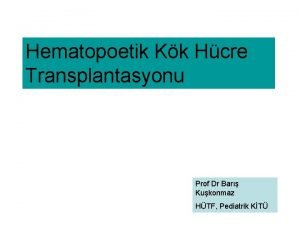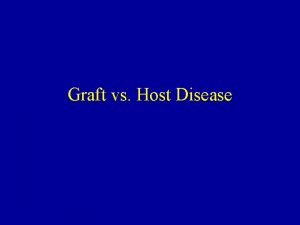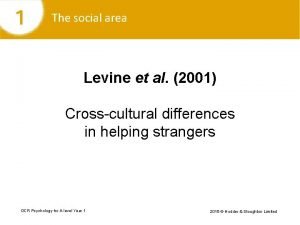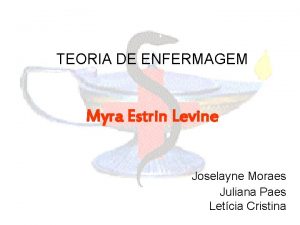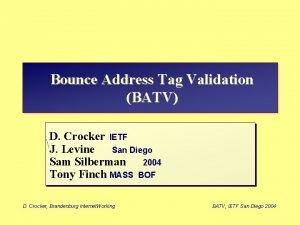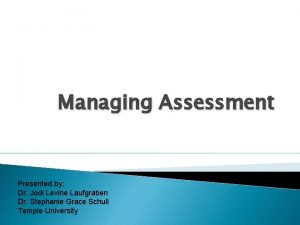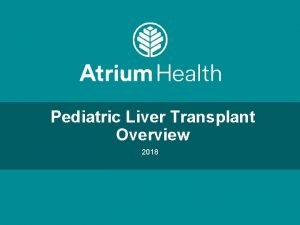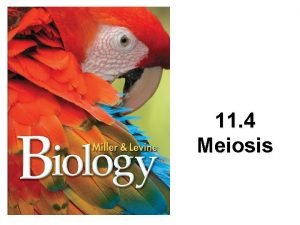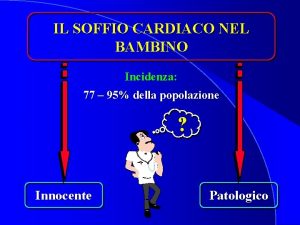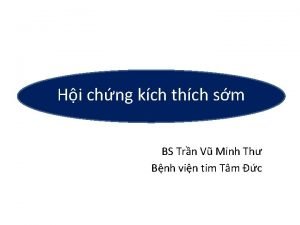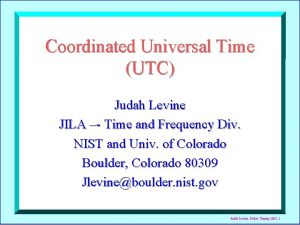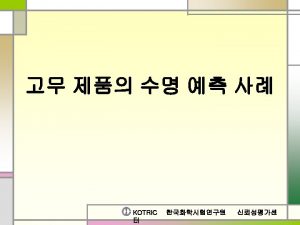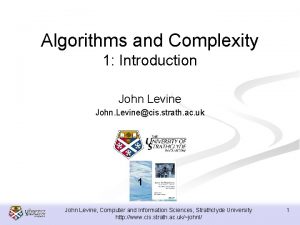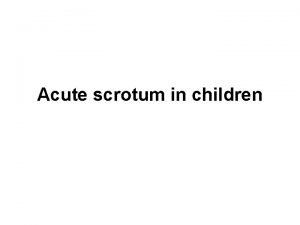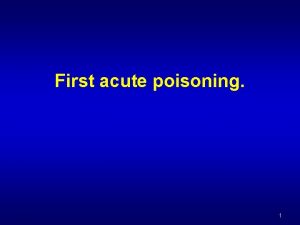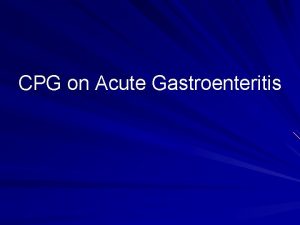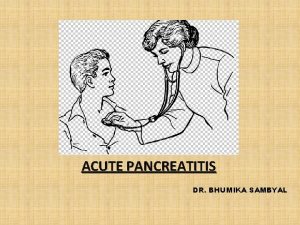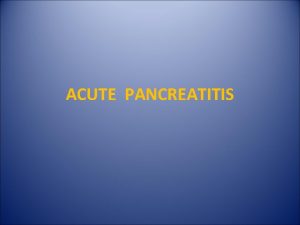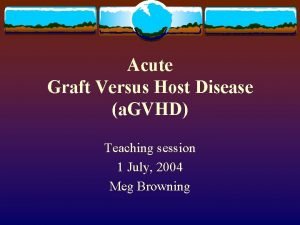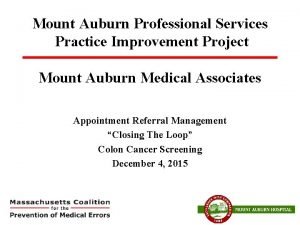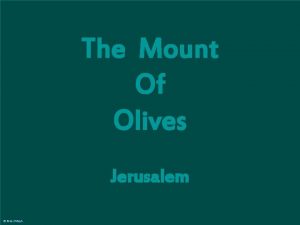GVHD Committee Acute GVHD Strategies John Levine Mount




















- Slides: 20

GVHD Committee: Acute GVHD Strategies John Levine Mount Sinai

Conflict of Interest Disclosure • GVHD biomarkers patent, consulting/research funding from Incyte 2

BMT CTN 2021 SOSS: GVHD Committee Member Center John Levine, Chair Mount Sinai Amin Alousi MD Anderson Brian Betts Minnesota Javier Bolanos-Meade Johns Hopkins Corey Cutler Dana Farber Mary Flowers Fred Hutchinson Steve Pavletic NCI Doris Ponce Memorial Sloan-Kettering Cancer Center Iskra Pusic Washington University in St. Louis Jennifer Whangbo Boston Children’s Rick Jones DCC liaison Haesook Kim Clinical Trials Design Liaison 3

Proposed Study Concepts 1. Treatment of High Risk GVHD by Targeting GI Epithelium 2. Minimize Treatment Toxicity for Low Risk Acute GVHD 3. Pre-emption of Moderate to Severe Chronic GVHD (to be presented during regimen related toxicity session) Overall strategy for acute GVHD: target the problem of under-treatment of high risk GVHD and over-treatment of low risk GVHD 4

High Risk GVHD: Hypothesis Treatments that repair damage to the GI tract will increase overall response rates and decrease non-relapse mortality (NRM) in patients with HR GVHD Importance to Field: Ongoing major cause of mortality Current treatments inadequate Immunosuppressives increase risk for infections 5

Background & Significance (1/5) 1. GVHD mortality is driven by treatment resistant GI GVHD – High risk patients can be identified at onset by clinical and/or biomarker risk factors – Clinical: Minnesota high risk (moderate-severe GI GVHD or multi-organ involvement) – Biomarkers (MAGIC algorithm): ST 2 + REG 3 (tissue injury biomarkers) = semi-quantitative measure of GI injury – Ann Arbor 2/3 accounts for 75% of GVHD related NRM, 35% of pts – AA 2/3 vs AA 1: Day 28 ORR: 57% vs 78%, p<0. 001; 12 m NRM: 36% vs 12%, p<0. 001 2. Intensified immunosuppression has not improved GVHD outcomes, e. g BMT CTN “pick the winner” or MMF vs placebo – Target tissue regeneration can be impaired by prolonged steroid therapy 6 Macmillan BBMT 2015, Hartwell JCI Insight 2017, Toubai Blood 2020

Background & Significance (2/5) High tissue resilience Target tissue resilience regulates treatment response Low tissue resilience Promote GI tissue repair: non-immunosuppressive Wu Trends Immunol 2017 7

Background & Significance (3/5) • IL-22 receptor expressed on GI tissue epithelium and promotes cell survival • GVHD leads to loss of IL-22 -producing host cells • IL-22 reversed loss of intestinal stem cells (ISCs) in established GVHD (murine model) (FIGURE) • F-652: recombinant fusion protein: human IL-22 dimer and Ig. G 2 Fc, longer half-life than human IL-22 • Phase 2 trial: 27 pts, GI GVHD (1 -4), 4 weekly doses – Day 28 ORR: 70% (19/27); AA 2/3 68% (13/19) Lindemans Nature 2015, Ponce ASTCT 2020 8

Background & Significance (4/5) • Cytokine inflammatory death mediated by RIPK 1 • Inhibition of RIPK 1 by necrostatin-1 s improves survival and protects ISCs in a murine GVHD model (FIGURE) • RIPK 1 inhibitors in clinical trials for IBD Ferrara lab, unpublished data 9

Background & Significance (5/5) • Epidermal growth factor (EGF) promotes epithelial repair – Protective in murine IBD model • • 62% Low EGF associated with severe GI GVHD HCG promotes tolerance Pregnyl (u. HCG, contains EGF) Phase 1 study: 13 Minn HR patients, 13 SR GVHD – Every other day SQ dosing x 7 days, then 2 x/wk – 1 st line: CR 62%, SR GVHD: CR 54% – FDA granted orphan drug designation 54% Holtan Blood Adv 2020 10

Trial Design • Platform: randomized phase 2 studies – suitable for introducing new agents, moving best to phase III • Key inclusion criteria: enrich for high risk GVHD (i. e. , grade IIIV/Ann Arbor 2/3) – High risk population: 35% of GVHD • Steroids + investigational agent • Primary endpoint: D 28 ORR, secondary: duration of response, NRM, relapse, OS, toxicities – 15% improvement in ORR (57% to 72%) would be meaningful 11

Feasibility & Logistics • Real-time biomarker screening is feasible (BMT CTN, MAGIC) • High risk biomarkers 35% of patients (screen 3, enroll 1); Minn HR 15% (screen 6, enroll 1) • Successful phase 2 trials can sequence into phase 3 trials • Requires collaboration with industry partners to gain access to agents Phase II Randomize F 652 (IL 22 agonist) RIPK 1 inhibitor Phase III Randomize winner soc Conduct 2 parallel arms (n=68 per arm, total n=136), advance agent(s) if ORR ≥ 69%. Phase 2 power 95%, alpha = 0. 028. 12

External Review & Online Feedback • In general, enthusiasm for BM-based enrichment strategy • Cellular therapies (T-regs, MSCs) are other options • Low enthusiasm for inhibition of T-cell trafficking to GI tract (dropped from presentation) • Microbiome manipulation is another strategy to consider 13

Low Risk GVHD: Hypothesis Decreased exposure to systemic steroid treatment will reduce morbidity in patients with LR GVHD Importance to Field: Consensus guidelines recommend high cumulative steroid tx even for responding patients (20 -40 mg/kg during first 4 weeks) MAGIC data confirms high cumulative steroid exposure (27 mg/kg) in LR pts High dose steroid tx leads to infections, organ toxicities, and poor QOL Martin BBMT 2012 14

Background & Significance (1/2) 1. Steroid treatment is toxic with short and long-term effects 2. Physicians prescribe high doses of steroids because they cannot predict whether responses will be sustained during tapers p=0. 003 Percent – Infections (esp viral), reduced QOL, diabetes, muscle/bone damage, neuropsychiatric effects – Impact worse for children, adolescents and older adults – Risk of steroid treatment decreases utilization of HCT in older adults 75 50 25 0 Topical Systemic Serious viral infections in Minn SR GVHD patients treated with topical steroids (blue, n=69) or systemic steroids (pink, n=108) – BMT CTN 1501: sirolimus monotherapy as effective as steroids, but ↑TMA, unsustained responses Matsumura-Kimoto BBMT 2016, Rosen Pediatr Rev 2019, Waljee BMJ 2017, Zuckerman Blood 2017, Mielcarek Haematologica 2015 15

Background & Significance (2/2) • Low risk GVHD can be identified at onset by clinical (Minn std risk) and biomarker criteria (AA 1) – 60% of all GVHD – Current practice: response to steroid treatment: 81%, NRM 5% – Non steroid treatment feasible (sirolimus); other options include JAK inhibitors • MAGIC algorithm validated as treatment response biomarker – Serial monitoring for two weeks by clinical and biomarker response identifies a large subset of “ultra-low risk” patients with exceptional outcomes – Response rate: 91%, NRM 2% – Ultra-low risk GVHD: 40% of all GVHD – Candidates for structured rapid steroid taper guided by continuous BM and clinical response with discontinuation (physiologic doses) in 4 weeks Pidala Blood 2020, Srinagesh Blood Adv 2019, unpublished MAGIC data 16

Trial Design • Randomized phase 2 trial comparing steroid-free treatment to guided rapid steroid taper • Key inclusion criteria: Low risk GVHD that requires tx w/ steroids – Exclude grade I GVHD and isolated UGI GVHD • Endpoints: ORR, serious virus infections, PROs, cumulative steroid dose, time to d/c of IST 17

Feasibility & Logistics • Real-time biomarker screening is feasible (BMT CTN, MAGIC) • Low risk GVHD: – 60% of all GVHD, large numbers of patients available for screening • Guided tapers: – Poor adherence to “recommended” steroid tapers – inform centers of weekly steroid dose based on clinical and BM results for better adherence • BMT CTN 1501 required 120 patients for randomized phase 2 (ORR endpoint) 18

External Review & Online Feedback • Reduction in steroid use is important – Some reviewers felt steroids are already tapered rapidly but multicenter data shows that rapid tapers are infrequent • Testing two “unknown” strategies at same time is problematic – Randomized phase 2 to move best options forward • Toxicity endpoints (e. g. infections or PROs) should be LR trial primary endpoints • No prophylaxis concepts – Prophylaxis is important but committee felt the greatest need was in treatment 19

Q&A Session 20
 Kordon kanı
Kordon kanı Diiyes
Diiyes How does levine link to the social area
How does levine link to the social area Myra e. levine
Myra e. levine Bounce address tag validation
Bounce address tag validation Dr jodi elliott
Dr jodi elliott Moreland and levine's model of group socialization
Moreland and levine's model of group socialization Levine childrens
Levine childrens Betsy atkinson
Betsy atkinson Miller and levine biology textbook
Miller and levine biology textbook Soffio sistolico 1/6 neonato
Soffio sistolico 1/6 neonato Levine scholarship deadline
Levine scholarship deadline Judah levine
Judah levine Sóng delta ecg
Sóng delta ecg Evie levine
Evie levine Dr. judah levine
Dr. judah levine Artists who appropriate
Artists who appropriate Rhetorical strategies in john smith's letter to queen anne
Rhetorical strategies in john smith's letter to queen anne Mount litera zee school ahmednagar
Mount litera zee school ahmednagar Mount st helens plates involved
Mount st helens plates involved Blessings listed by jesus in the sermon on the mount senai
Blessings listed by jesus in the sermon on the mount senai
